Mario Bros. (series): Difference between revisions
From the Super Mario Wiki, the Mario encyclopedia
Jump to navigationJump to search
m (Text replacement - "{{Mario games}}" to "{{Super Mario games}}") |
LinkTheLefty (talk | contribs) mNo edit summary |
||
| (24 intermediate revisions by 10 users not shown) | |||
| Line 6: | Line 6: | ||
|latest=''[[Mario Clash]]'' ([[List of games by date#1995|1995]]) | |latest=''[[Mario Clash]]'' ([[List of games by date#1995|1995]]) | ||
|number= | |number= | ||
| | |franchise=''[[Super Mario (franchise)|Super Mario]]'' | ||
|staff= | |staff= | ||
}} | }} | ||
The '''''Mario Bros.''''' series is a video game series | The '''''Mario Bros.''''' series is a video game series in the [[Super Mario (franchise)|''Super Mario'' franchise]], deriving from [[Mario Bros. (game)|the original 1983 arcade game of the same name]]. | ||
{{br|toc=1}} | |||
==List of games== | ==List of games== | ||
{|align=center width=100% class="wikitable" | {|align=center width=100% class="wikitable" | ||
|- | |- | ||
!style="background-color: #d9d9d9;font-size:125%;text-align:left"colspan="2"|Title | !style="background-color:#d9d9d9;font-size:125%;text-align:left"colspan="2"|Title | ||
|- | |- | ||
!width=150 style="background-color: #e0e0e0;"|Cover, original release and system | !width=150 style="background-color:#e0e0e0;"|Cover, original release and system | ||
!style="background-color: #e0e0e0;"|Synopsis | !style="background-color:#e0e0e0;"|Synopsis | ||
|- | |- | ||
!colspan="2"style="font-size:125%;text-align:left"|''[[Mario Bros. (game)|Mario Bros.]]'' | !colspan="2"style="font-size:125%;text-align:left"|''[[Mario Bros. (game)|Mario Bros.]]'' | ||
|- | |- | ||
|style="text-align:center"|[[File:MarioBrosFlyer.png|145x145px]]<span style="font-size:8pt"><br>{{ | |style="text-align:center"|[[File:MarioBrosFlyer.png|145x145px]]<span style="font-size:8pt"><br>{{flag list|Japan|June 21, 1983}}Arcade machine</span> | ||
|'''''Mario Bros.''''' is the second arcade game starring [[Mario]] as a protagonist, coming after ''[[Donkey Kong (game)|Donkey Kong]]''. The game's main attraction was featuring cooperative two-player functionality with Mario's recently introduced brother, [[Luigi]]. The two are in a sewer, battling various enemies leaking from the plumbing, | |'''''Mario Bros.''''' is the second arcade game starring [[Mario]] as a protagonist, coming after ''[[Donkey Kong (game)|Donkey Kong]]''. The game's main attraction was featuring cooperative two-player functionality with Mario's recently introduced brother, [[Luigi]]. The two are in a sewer, battling various enemies leaking from the plumbing, hitting the [[floor]]s underneath them to stun them before kicking them away. Many aspects from this game recur in later games of the ''Super Mario'' franchise, notably [[coin]]s, [[Warp Pipe|pipe]]s, [[POW Block]]s, and enemy [[Shellcreeper|turtle]]s. The game has been ported innumerable times to various systems. | ||
|- | |- | ||
!colspan="2"style="font-size:125%;text-align:left"|''[[Mario Bros. Special]]'' | !colspan="2"style="font-size:125%;text-align:left"|''[[Mario Bros. Special]]'' | ||
|- | |- | ||
|style="text-align:center"|[[File:Mariopkg.jpg|145x145px]]<span style="font-size:8pt"><br>{{ | |style="text-align:center"|[[File:Mariopkg.jpg|145x145px]]<span style="font-size:8pt"><br>{{flag list|Japan|August 1984}}Home computer</span> | ||
|'''''Mario Bros. Special''''' is a Japan-only computer game developed by [[Hudson Soft]]. It has altered gameplay with stages where Mario or Luigi must complete specific tasks, such as pressing switches or collecting $ symbols. | |'''''Mario Bros. Special''''' is a Japan-only computer game developed by [[Hudson Soft]]. It has altered gameplay with stages where Mario or Luigi must complete specific tasks, such as pressing switches or collecting $ symbols. | ||
|- | |- | ||
!colspan="2"style="font-size:125%;text-align:left"|''[[Punch Ball Mario Bros.]]''</span> | !colspan="2"style="font-size:125%;text-align:left"|''[[Punch Ball Mario Bros.]]''</span> | ||
|- | |- | ||
|style="text-align:center"|[[File:PBMB Boxart.jpg|145x145px]]<span style="font-size:8pt"><br>{{ | |style="text-align:center"|[[File:PBMB Boxart.jpg|145x145px]]<span style="font-size:8pt"><br>{{flag list|Japan|October 5, 1984}}Home computer</span> | ||
|'''''Punch Ball Mario Bros.''''' is another Japanese computer-based sequel by Hudson Soft. It features stone "[[Punch Ball]]s" that must be thrown at enemies to stun them. | |'''''Punch Ball Mario Bros.''''' is another Japanese computer-based sequel by Hudson Soft. It features stone "[[Punch Ball]]s" that must be thrown at enemies to stun them. | ||
|- | |- | ||
!colspan="2"style="font-size:125%;text-align:left"|''[[ | !colspan="2"style="font-size:125%;text-align:left"|''[[Mario Clash]]''</span> | ||
|- | |||
|style="text-align:center"|[[File:MarioClash.jpg|145x145px]]<span style="font-size:8pt"><br>{{flag list|Japan|September 28, 1995}}[[Virtual Boy]]</span> | |||
|'''''Mario Clash''''', unlike its predecessors, stars only Mario, but it otherwise keeps the same gameplay formula. It takes place in the [[Clash House]], where Mario needs to defeat invading enemies in both the standard playing field and the background by using the [[Virtual Boy]]'s depth and [[Koopa Shell|Koopa shells]]. | |||
|} | |||
===Remakes and compilations=== | |||
{|align=center width=100% class="wikitable" | |||
|- | |||
!style="background-color:#d9d9d9;font-size:125%;text-align:left"colspan="2"|Title | |||
|- | |||
!width=150 style="background-color:#e0e0e0;"|Cover, original release and system | |||
!style="background-color:#e0e0e0;"|Synopsis | |||
|- | |- | ||
!colspan="2"style="font-size:125%;text-align:left"|''[[Mario Bros. Returns]]'' | |||
|- | |- | ||
!colspan="2"style="font-size:125%;text-align:left"|''[[Mario | |style="text-align:center"|[[File:Kaettekita Mario Bros Title.png|145x145px]]<span style="font-size:8pt"><br>{{flag list|Japan|November 30, 1988}}[[Family Computer Disk System]]</span> | ||
|'''''Mario Bros. Returns''''' is a Japan-only game for the [[Family Computer Disk System]], being mostly a more graphically accurate port of the original arcade game than the 1983 [[Family Computer]] and [[Nintendo Entertainment System]] port in the [[Arcade Classics Series]]. However, it also has new features, such as the ability to change direction mid-[[jump]] and a slot machine [[minigame]]. Many of its graphical enhancements were used in a 1993 European NES port of ''Mario Bros.'' for the [[Nintendo Classics|Classic Series]]. | |||
|- | |||
!colspan="2" style="font-size:125%;text-align:left"|''[[Donkey Kong/Donkey Kong Junior/Mario Bros.]]'' | |||
|- | |- | ||
|style="text-align:center"|[[File: | |style="text-align:center"|[[File:DK DKjr MB upright.png|145x145px]]<span style="font-size:8pt"><br>{{flag list|USA|2004}}Arcade machine</span> | ||
|'''''Mario | |'''''Donkey Kong/Donkey Kong Junior/Mario Bros.''''' is an arcade system, only found in America, in which players could choose which of the three games they wanted to play. | ||
|} | |} | ||
===Related games=== | ===Related games=== | ||
{|align=center width=100% class="wikitable" | {|align=center width=100% class="wikitable" | ||
|- | |- | ||
!style="background-color: #d9d9d9;font-size:125%;text-align:left"colspan="2"|Title | !style="background-color:#d9d9d9;font-size:125%;text-align:left"colspan="2"|Title | ||
|- | |- | ||
!width=150 style="background-color: #e0e0e0;"|Cover, original release, and system | !width=150 style="background-color:#e0e0e0;"|Cover, original release, and system | ||
!style="background-color: #e0e0e0;"|Synopsis | !style="background-color:#e0e0e0;"|Synopsis | ||
|- | |- | ||
!colspan="2"style="font-size:125%;text-align:left"|''[[Mario Bros. (Game & Watch)|Mario Bros.]]'' ([[Game & Watch]]) | !colspan="2"style="font-size:125%;text-align:left"|''[[Mario Bros. (Game & Watch)|Mario Bros.]]'' ([[Game & Watch]]) | ||
|- | |- | ||
|style="text-align:center"|[[File:Gandwmbros.jpg|145x145px]]<span style="font-size:8pt"><br>March 14, 1983<br>[[Game & Watch]]</span> | |style="text-align:center"|[[File:Gandwmbros.jpg|145x145px]]<span style="font-size:8pt"><br>March 14, 1983<br>[[Game & Watch]]</span> | ||
|The [[Game & Watch]] game '''''Mario Bros.''''' was released before the arcade game (and as such is technically the first appearance of Luigi), though it also started development later. Gameplay-wise, the games have nothing in common, with the Game & Watch game featuring Mario and Luigi working in a bottling plant, with one of the brothers appearing on each of its two screens. It was ported to both ''[[Game & Watch Gallery 3]]'' and ''[[Game & Watch Gallery 4]]''. | |The [[Game & Watch]] game '''''Mario Bros.''''' was released before the arcade game (and, as such, is technically the first appearance of Luigi), though it also started development later. Gameplay-wise, the games have nothing in common, with the Game & Watch game featuring Mario and Luigi working in a bottling plant, with one of the brothers appearing on each of its two screens. It was ported to both ''[[Game & Watch Gallery 3]]'' and ''[[Game & Watch Gallery 4]]''. | ||
|- | |- | ||
!colspan="2"style="font-size:125%;text-align:left"|''[[Super Mario Bros. 3]]'' | !colspan="2"style="font-size:125%;text-align:left"|''[[Super Mario Bros. 3]]'' | ||
|- | |- | ||
|style="text-align:center"|[[File: | |style="text-align:center"|[[File:Mario3rightbros.png|145x145px]]<span style="font-size:8pt"><br>{{flag list|Japan|October 23, 1988}}[[Nintendo Entertainment System]]</span> | ||
|'''''Super Mario Bros. 3''''' features a battle mode called "Classic Mario Bros.," which is an altered version of the original. It is the first rendition to replace [[Shellcreeper]]s with [[Spiny|Spinies]]. A further edited version appears in the ''[[Super Mario All-Stars]]'' version of ''Super Mario Bros. 3''. | |'''''Super Mario Bros. 3''''' features a battle mode called "[[Mario Bros. (Super Mario Bros. 3)|Classic Mario Bros.]]," which is an altered version of the original. It is the first rendition to replace [[Shellcreeper]]s with [[Spiny|Spinies]]. A further [[Battle Game (Super Mario All-Stars)|edited version]] appears in the ''[[Super Mario All-Stars]]'' version of ''Super Mario Bros. 3''. | ||
|- | |- | ||
!colspan="2"style="font-size:125%;text-align:left"|''[[Super Mario Advance]]'' | !colspan="2"style="font-size:125%;text-align:left"|''[[Super Mario Advance]]'' | ||
|- | |- | ||
|style="text-align:center"|[[File:SMA.jpg|145x145px]]<span style="font-size:8pt"><br>{{ | |style="text-align:center"|[[File:SMA.jpg|145x145px]]<span style="font-size:8pt"><br>{{flag list|Japan|March 21, 2001}} [[Game Boy Advance]]</span> | ||
|'''''Super Mario Advance''''' also features an alternate mode based on ''Mario Bros.'', having both a normal mode and a battle mode. Additionally, it can have up to four players and features some other new elements, such as [[ | |'''''Super Mario Advance''''' also features an [[Mario Bros. (Game Boy Advance)|alternate mode based on ''Mario Bros.'']], having both a normal mode and a battle mode. Additionally, it can have up to four players and features some other new elements, such as [[Trash Can|garbage can]]s and [[Bowser]]. This mode returns in every other [[Super Mario Advance (series)|''Super Mario Advance'' game]] as well as ''[[Mario & Luigi: Superstar Saga]]''. | ||
|- | |- | ||
!colspan="2"style="font-size:125%;text-align:left"|''[[Super Mario 3D World]]'' | !colspan="2"style="font-size:125%;text-align:left"|''[[Super Mario 3D World]]'' | ||
|- | |- | ||
|style="text-align:center"|[[File:Box NA - Super Mario 3D World.png|145x145px]]<span style="font-size:8pt"><br>{{ | |style="text-align:center"|[[File:Box NA - Super Mario 3D World.png|145x145px]]<span style="font-size:8pt"><br>{{flag list|Japan|November 21, 2013}}[[Wii U]]</span> | ||
|'''''Super Mario 3D World''''' features an alternate mode with an edited port of the first NES version, called "''Luigi Bros.''" It replaces Mario with Luigi's modern colors, keeping the original Luigi the same. | |'''''Super Mario 3D World''''' features an alternate mode with an edited port of the first NES version, called "''[[Luigi Bros.]]''" It replaces Mario with Luigi's modern colors, keeping the original Luigi the same. | ||
|} | |} | ||
==See also== | |||
*''[[Wrecking Crew (series)|Wrecking Crew]]'', a series using a similar layout of stacked platforms. | |||
*''[[Hotel Mario]]'', a game that also uses a similar layout. | |||
{{Game series}} | |||
{{Super Mario games}} | {{Super Mario games}} | ||
[[Category:Mario Bros. series|*]] | |||
[[Category:Game series]] | [[Category:Game series]] | ||
Latest revision as of 18:46, January 29, 2025
- This article is about the series of games based around the arcade Mario Bros. For the series based around Super Mario Bros., see Super Mario (series).
| Mario Bros. | |
|---|---|

| |
| First installment | Mario Bros. (1983) |
| Latest installment | Mario Clash (1995) |
| Franchise | Super Mario |
The Mario Bros. series is a video game series in the Super Mario franchise, deriving from the original 1983 arcade game of the same name.
List of games[edit]
| Title | |
|---|---|
| Cover, original release and system | Synopsis |
| Mario Bros. | |
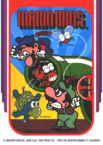 Arcade machine |
Mario Bros. is the second arcade game starring Mario as a protagonist, coming after Donkey Kong. The game's main attraction was featuring cooperative two-player functionality with Mario's recently introduced brother, Luigi. The two are in a sewer, battling various enemies leaking from the plumbing, hitting the floors underneath them to stun them before kicking them away. Many aspects from this game recur in later games of the Super Mario franchise, notably coins, pipes, POW Blocks, and enemy turtles. The game has been ported innumerable times to various systems. |
| Mario Bros. Special | |
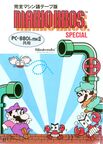 Home computer |
Mario Bros. Special is a Japan-only computer game developed by Hudson Soft. It has altered gameplay with stages where Mario or Luigi must complete specific tasks, such as pressing switches or collecting $ symbols. |
| Punch Ball Mario Bros. | |
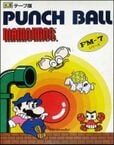 Home computer |
Punch Ball Mario Bros. is another Japanese computer-based sequel by Hudson Soft. It features stone "Punch Balls" that must be thrown at enemies to stun them. |
| Mario Clash | |
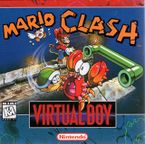 Virtual Boy |
Mario Clash, unlike its predecessors, stars only Mario, but it otherwise keeps the same gameplay formula. It takes place in the Clash House, where Mario needs to defeat invading enemies in both the standard playing field and the background by using the Virtual Boy's depth and Koopa shells. |
Remakes and compilations[edit]
| Title | |
|---|---|
| Cover, original release and system | Synopsis |
| Mario Bros. Returns | |
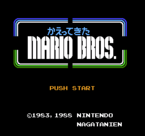 Family Computer Disk System |
Mario Bros. Returns is a Japan-only game for the Family Computer Disk System, being mostly a more graphically accurate port of the original arcade game than the 1983 Family Computer and Nintendo Entertainment System port in the Arcade Classics Series. However, it also has new features, such as the ability to change direction mid-jump and a slot machine minigame. Many of its graphical enhancements were used in a 1993 European NES port of Mario Bros. for the Classic Series. |
| Donkey Kong/Donkey Kong Junior/Mario Bros. | |
 Arcade machine |
Donkey Kong/Donkey Kong Junior/Mario Bros. is an arcade system, only found in America, in which players could choose which of the three games they wanted to play. |
Related games[edit]
| Title | |
|---|---|
| Cover, original release, and system | Synopsis |
| Mario Bros. (Game & Watch) | |
 March 14, 1983 Game & Watch |
The Game & Watch game Mario Bros. was released before the arcade game (and, as such, is technically the first appearance of Luigi), though it also started development later. Gameplay-wise, the games have nothing in common, with the Game & Watch game featuring Mario and Luigi working in a bottling plant, with one of the brothers appearing on each of its two screens. It was ported to both Game & Watch Gallery 3 and Game & Watch Gallery 4. |
| Super Mario Bros. 3 | |
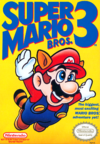 Nintendo Entertainment System |
Super Mario Bros. 3 features a battle mode called "Classic Mario Bros.," which is an altered version of the original. It is the first rendition to replace Shellcreepers with Spinies. A further edited version appears in the Super Mario All-Stars version of Super Mario Bros. 3. |
| Super Mario Advance | |
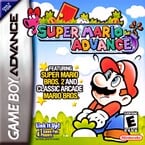 Game Boy Advance |
Super Mario Advance also features an alternate mode based on Mario Bros., having both a normal mode and a battle mode. Additionally, it can have up to four players and features some other new elements, such as garbage cans and Bowser. This mode returns in every other Super Mario Advance game as well as Mario & Luigi: Superstar Saga. |
| Super Mario 3D World | |
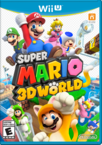 Wii U |
Super Mario 3D World features an alternate mode with an edited port of the first NES version, called "Luigi Bros." It replaces Mario with Luigi's modern colors, keeping the original Luigi the same. |
See also[edit]
- Wrecking Crew, a series using a similar layout of stacked platforms.
- Hotel Mario, a game that also uses a similar layout.